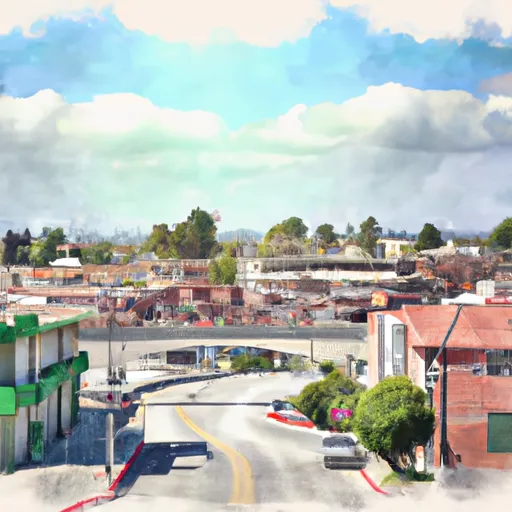-
 Snoflo Premium
Snoflo Premium
Get unlimited access to all our content
With no Ad interruptions! - Start Your Free Trial Login with existing account
Rialto
Eden Index
Climate
9.1
•
Recreation
8.2
•
Community
2.1
•
Safeguard
7.0/10

Rialto, California is a vibrant city located in San Bernardino County. It enjoys a Mediterranean climate characterized by hot, dry summers and mild, wet winters. Summers in Rialto are typically arid and can reach temperatures above 90°F (32°C), while winters remain mild with temperatures averaging around 60°F (15°C). The city experiences very little rainfall throughout the year, with an annual average of around 15 inches (38 cm).
Rialto is situated near the San Bernardino Mountains and is surrounded by various hydrological features. The city is located along the Santa Ana River, which provides a source of water and plays a crucial role in the local hydrology. There are also several creeks and washes that traverse the area, contributing to the hydrological makeup of the region.
For outdoor enthusiasts, Rialto offers numerous recreational opportunities. The nearby San Bernardino Mountains provide opportunities for hiking, camping, and scenic drives. Within the city, there are several parks, such as Frisbie Park and Lytle Creek Park, that offer amenities like picnic areas, sports fields, and playgrounds. The city also has various sports facilities and community centers that cater to different recreational activities, including swimming, basketball, and tennis.
What is the Eden Index?
The Snoflo Eden Index serves as a comprehensive rating system for regions, evaluating their desirability through a holistic assessment of climate health, outdoor recreation opportunities, and natural disaster risk, acknowledging the profound impact of these factors on livability and well-being.
Climate Health Indicator (CHI): 9.1
Rialto receives approximately
433mm of rain per year,
with humidity levels near 75%
and air temperatures averaging around
19°C.
Rialto has a plant hardyness factor of
10, meaning
plants and agriculture in this region tend to thrive here all year round.
By considering the ideal temperature range, reliable water supplies, clean air, and stable seasonal rain or snowpacks, the Climate Health Indicator (CHI) underscores the significance of a healthy climate as the foundation for quality living.
A healthy climate is paramount for ensuring a high quality of life and livability in a region, fostering both physical well-being and environmental harmony. This can be characterized by ideal temperatures, reliable access to water supplies, clean air, and consistent seasonal rain or snowpacks.
Weather Forecast
Streamflow Conditions
Santa Ana
Area Rivers
Santa Ana
Snowpack Depths
Santa Ana
Reservoir Storage Capacity
Santa Ana
Groundwater Levels
Recreational Opportunity Index (ROI): 8.2
The Recreational Opportunity Index (ROI) recognizes the value of outdoor recreational options, such as parks, hiking trails, camping sites, and fishing spots, while acknowledging that climate plays a pivotal role in ensuring the comfort and consistency of these experiences.
Access to outdoor recreational opportunities, encompassing activities such as parks, hiking, camping, and fishing, is crucial for overall well-being, and the climate plays a pivotal role in enabling and enhancing these experiences, ensuring that individuals can engage in nature-based activities comfortably and consistently.
Camping Areas
| Campground | Campsites | Reservations | Toilets | Showers | Elevation |
|---|---|---|---|---|---|
| Rancho Jurupa Park | 67 | 751 ft | |||
| Lake Perris State Rec Area | 351 | 1,600 ft | |||
| March ARB Military | None | 1,509 ft | |||
| Applewhite | 44 | 3,306 ft | |||
| Dogwood | 93 | 5,739 ft | |||
| Blue Jay | 50 | 3,358 ft | |||
| El Cariso | 24 | 2,568 ft | |||
| Lake Elsinore | 400 | 1,286 ft | |||
| Silverwood Lake State Rec Area | 131 | 3,373 ft | |||
| Glen Helen Regional Park | 47 | 1,993 ft |
Catastrophe Safeguard Index (CSI):
The Catastrophe Safeguard Index (CSI) recognizes that natural disaster risk, encompassing floods, fires, hurricanes, and tornadoes, can drastically affect safety and the overall appeal of an area.
The level of natural disaster risk in a region significantly affects safety and the overall livability, with climate change amplifying these risks by potentially increasing the frequency and intensity of events like floods, fires, hurricanes, and tornadoes, thereby posing substantial challenges to community resilience and well-being.
Community Resilience Indicator (CRI): 2.1
The Community Resilience Indicator (CRI) recognizes that education, healthcare, and socioeconomics are crucial to the well-being of a region. The CRI acknowledges the profound impact of these elements on residents' overall quality of life. By evaluating educational resources, healthcare accessibility, and economic inclusivity, the index captures the essential aspects that contribute to a thriving community, fostering resident satisfaction, equity, and social cohesion.

